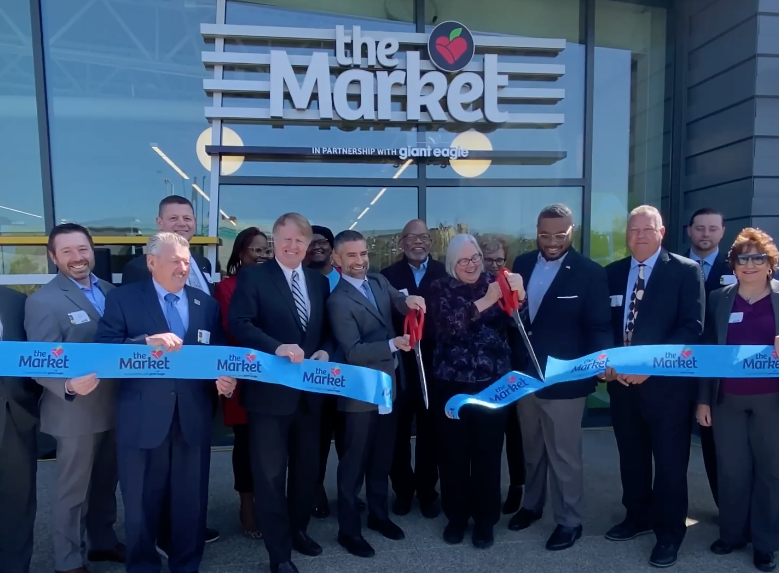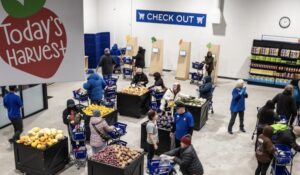More food banks are seeking to expand their missions beyond food distribution to include community engagement – and they have the infrastructure to prove it.
The Greater Pittsburgh Community Food Bank and Nourishing Hope of Chicago are among the organizations that have recently unveiled space that positions them to more deeply connect with groups and individuals in their communities.
The new buildings underscore a departure from the days when a warehouse was a food bank’s main real estate asset, and the food bank was far removed from any interaction with clients. With their refreshed infrastructures, food banks are making it easier and more inviting for clients to access food and other assistance.
“We believe by expanding our infrastructure and our programming, all our neighbors will have food today, tomorrow and for a lifetime,” said Lisa Scales, President and CEO of Greater Pittsburgh Community Food Bank, at a recent event.
Scales was announcing The Market, a grocery-store-style pantry that will soon open as part of a renovation of the food bank’s existing warehouse. The 5,600-square-foot facility, created in partnership with local supermarket chain Giant Eagle, will feature fresh produce and other staples of high nutritional value, along with a nutrition kitchen and education station. The Market also lets shoppers place food orders online and schedule convenient pick ups via Feeding America’s Order Ahead service, which the food bank has been piloting for about 18 months.

The Market echoes other infrastructure projects that are bringing food banks into closer connection with end-user clients. The Community Food Bank of Atlanta, for example, directly owns and operates large-scale Community Food Centers that serve as client-choice pantries in high-need neighborhoods. Northwest Arkansas Food Bank in March opened a client-choice pantry, strategically located across the street from a community center where people can get other wrap-around services. These food banks are part of a growing list of food banks running their own outlets for food distribution.
Greater Pittsburgh Community Food Bank built The Market with three community audiences in mind, said Charlese McKinney, Director of Partner Network Programs.
The first is the people who don’t normally seek out food assistance, but would benefit from doing so. “We wanted to be able to really de-stigmatize food assistance for the families who don’t visit us, but need us,” McKinney said. “We created a beautiful space that’s well-stocked, where people can let their guard down and feel very comfortable.”
Another audience is the community at large. The food bank envisions community members gathering at The Market for cooking demos, nutrition classes or even Zumba dance parties. “It will be a destination spot where the community comes together,” McKinney said.
Finally, The Market will serve the 350 food pantries in the food bank’s network, which will use the space as a learning lab to test new distribution models, among other things. The learning lab will be paired with a Partner Excellence Academy to be launched in the fall and will test different ways of distributing food via pantries, including expanded hours of access, online ordering with pre-scheduled pickups, and refrigerated lockers for storing food until pickup.

The Market’s learning lab will also help the food bank accommodate and learn from a new segment of food assistance partners: community-based organizations that do not have a primary mission of serving food, but started doing so during the pandemic to meet heightened demand. “We have a whole new group of partners that are community-based organizations,” McKinney said.
Nourishing Hope (formerly Lakeview Pantry) also had community partners in mind when it opened its new headquarters. Before the pandemic, Nourishing Hope had thought that it might build three to five new pantries to help it broaden its reach beyond the three facilities it already had. But it found during the pandemic that it was supporting a lot of pop-up distributions run by community groups. So it evolved its infrastructure and food distribution strategy to better align with the needs of those groups.
Now, about ten community groups, including schools, shelters and social service agencies, have become partners by making Nourishing Hope’s online ordering system available to their clients. The new headquarters gives Nourishing Hope ample space to pick and bag the food, put it on pallets, and send it out to community partners where clients can easily pick it up.
The new space is not a walk-in food pantry. “Our strategy has evolved to trying to get the food to where people are, versus they come to us for food,” said Kellie O’Connell, CEO.
The new headquarters will also host twice-a-week drive-through pick-ups for people who order food online directly from Nourishing Hope. And because of its central location, the new facility supports the packing and distribution of home delivery orders to more places. (While home delivery orders are currently standardized, Nourishing Hope expects eventually to use the online ordering tool to offer customized home delivery options, as well.)
Nourishing Hope still sees most of its clients come in through its walk-in pantries. At the same time, its volume of online orders has grown significantly, from less than 1,000 in the year before the pandemic to about 6,000 last year. Referring to its walk-in pantries, its online market partners and home delivery partners, O’Connell said “all three programs are about getting food to people.”
Nourishing Hope, which also offers mental health services, expects to add several more community partners in the coming year, especially in areas with high need. “It’s less about volume, and more about getting food into the places that need it,” O’Connell noted.
Nourishing Hope’s new headquarters came along at a good time to support its evolving strategy to work as a partner with community groups to support food access. “One positive thing that emerged from the pandemic was the opportunity to work with lots of different types of groups that maybe we never would have thought to partner with.” O’Connell said. “As we look to the future of the charitable food system, we’re really thinking about how to activate those partnerships.” – Chris Costanzo
CAPTION ABOVE: CEO Lisa Scales, holding scissors, at an event announcing Greater Pittsburgh Community Food Bank’s The Market.
Like what you’re reading?
Support Food Bank News









